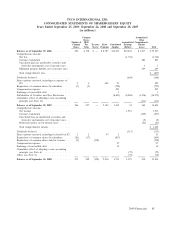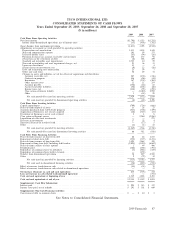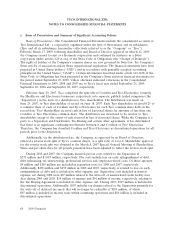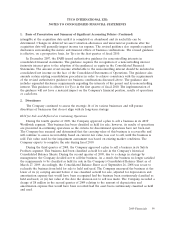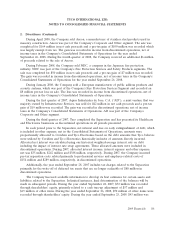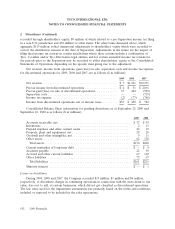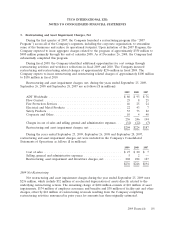ADT 2009 Annual Report Download - page 185
Download and view the complete annual report
Please find page 185 of the 2009 ADT annual report below. You can navigate through the pages in the report by either clicking on the pages listed below, or by using the keyword search tool below to find specific information within the annual report.TYCO INTERNATIONAL LTD.
NOTES TO CONSOLIDATED FINANCIAL STATEMENTS
1. Basis of Presentation and Summary of Significant Accounting Policies (Continued)
assets to be disposed of, if any, are based on the estimated proceeds to be received, less costs of
disposal.
Goodwill and Indefinite-Lived Intangible Asset Impairments—Goodwill and indefinite-lived intangible
assets are assessed for impairment annually and more frequently if triggering events occur (see
Note 10). In performing these assessments, management relies on various factors, including operating
results, business plans, economic projections, anticipated future cash flows, comparable transactions and
other market data. There are inherent uncertainties related to these factors which require judgment in
applying them to the analysis of goodwill and indefinite-lived intangible assets for impairment. The
Company performed its annual impairment tests for goodwill and indefinite-lived intangible assets on
the first day of the fourth quarter of 2009.
When testing for goodwill impairment, the Company first compares the fair value of a reporting
unit with its carrying amount. Fair value for the goodwill impairment test is determined utilizing a
discounted cash flow analysis based on the Company’s future budgets discounted using market
participants’ weighted-average cost of capital and market indicators of terminal year cash flows. Other
valuation methods are used to corroborate the discounted cash flow method. If the carrying amount of
a reporting unit exceeds its fair value, goodwill is considered potentially impaired and further tests are
performed to measure the amount of impairment loss. In the second step of the goodwill impairment
test, the Company compares the implied fair value of the reporting unit’s goodwill with the carrying
amount of the reporting unit’s goodwill. If the carrying amount of the reporting unit’s goodwill exceeds
the implied fair value of that goodwill, an impairment loss is recognized in an amount equal to the
excess of the carrying amount of goodwill over its implied fair value. The implied fair value of goodwill
is determined in the same manner that the amount of goodwill recognized in a business combination is
determined. The Company allocates the fair value of a reporting unit to all of the assets and liabilities
of that unit, including intangible assets, as if the reporting unit had been acquired in a business
combination. Any excess of the fair value of a reporting unit over the amounts assigned to its assets
and liabilities represents the implied fair value of goodwill.
Indefinite lived intangible assets consisting primarily of trade names and franchise rights are tested
for impairment using either a relief from royalty method or excess earnings method.
Dealer and Other Amortizable Intangible Assets, Net—Intangible assets primarily include contracts
and related customer relationships and intellectual property. Certain contracts and related customer
relationships result from purchasing residential security monitoring contracts from an external network
of independent dealers who operate under the ADT dealer program. Acquired contracts and related
customer relationships are recorded at their contractually determined purchase price.
During the first six months (twelve months in certain circumstances) after the purchase of the
customer contract, any cancellation of monitoring service, including those that result from customer
payment delinquencies, results in a chargeback by the Company to the dealer for the full amount of
the contract purchase price. The Company records the amount charged back to the dealer as a
reduction of the previously recorded intangible asset.
Intangible assets arising from the ADT dealer program described above are amortized in pools
determined by the same month and year of contract acquisition on an accelerated basis over the period
and pattern of economic benefit that is expected to be obtained from the customer relationship.
2009 Financials 93




